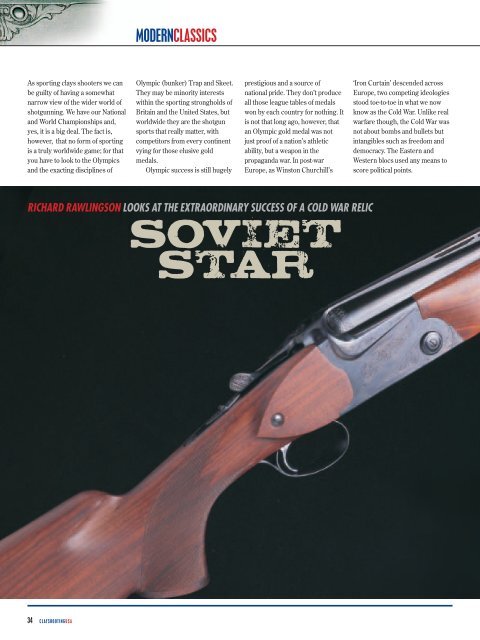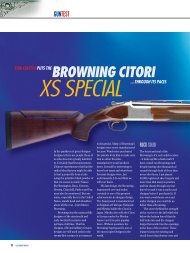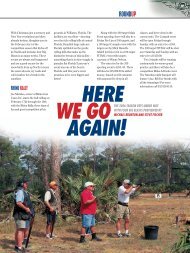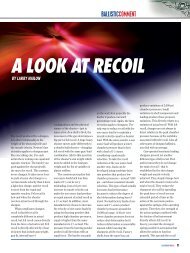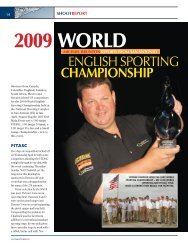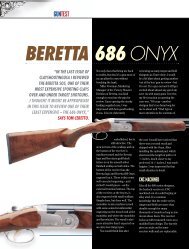You also want an ePaper? Increase the reach of your titles
YUMPU automatically turns print PDFs into web optimized ePapers that Google loves.
As sporting clays shooters we can<br />
be guilty of having a somewhat<br />
narrow view of the wider world of<br />
shotgunning. We have our National<br />
and World Championships and,<br />
yes, it is a big deal. The fact is,<br />
however, that no form of sporting<br />
is a truly worldwide game; for that<br />
you have to look to the Olympics<br />
and the exacting disciplines of<br />
Olympic (bunker) Trap and Skeet.<br />
They may be minority interests<br />
within the sporting strongholds of<br />
Britain and the United States, but<br />
worldwide they are the shotgun<br />
sports that really matter, with<br />
competitors from every continent<br />
vying for those elusive gold<br />
medals.<br />
Olympic success is still hugely<br />
prestigious and a source of<br />
national pride. They don’t produce<br />
all those league tables of medals<br />
won by each country for nothing. It<br />
is not that long ago, however, that<br />
an Olympic gold medal was not<br />
just proof of a nation’s athletic<br />
ability, but a weapon in the<br />
propaganda war. In post-war<br />
Europe, as Winston Churchill’s<br />
RICHARD RAWLINGSON LOOKS AT THE EXTRAORDINARY SUCCESS OF A COLD WAR RELIC<br />
<strong>SOVIET</strong><br />
<strong>STAR</strong><br />
34 CLAYSHOOTINGUSA<br />
MODERNCLASSICS<br />
‘Iron Curtain’ descended across<br />
Europe, two competing ideologies<br />
stood toe-to-toe in what we now<br />
know as the Cold War. Unlike real<br />
warfare though, the Cold War was<br />
not about bombs and bullets but<br />
intangibles such as freedom and<br />
democracy. The Eastern and<br />
Western blocs used any means to<br />
score political points.
Sport became a key Cold War<br />
battleground, especially for the<br />
Communist world. If their athletes<br />
could stand proudly on every<br />
podium it would proclaim the<br />
superiority of the system that<br />
selected and trained them.<br />
Western decadence could surely<br />
not hope to compete with State<br />
controlled efficiency.<br />
All international sport was<br />
important, but none more so than<br />
the Olympic Games. Every four<br />
years, the entire world focused on<br />
the performance of its elite<br />
athletes. In propaganda terms,<br />
medals were worth much more<br />
than their weight in gold. In the<br />
Soviet Union every single Olympic<br />
sport became a priority and that<br />
IT MAY NOT BE SUBTLE BUT IT’S<br />
ANYTHING BUT CRUDE! THE FACTORY<br />
NOW ALSO PRODUCES HIGH GRADE<br />
VERSIONS (BELOW LEFT) AND IN<br />
BRIGHT FINISH (RIGHT).<br />
MODERNCLASSICS<br />
included target shooting and the<br />
shotgun disciplines.<br />
Soviet shotgunners however<br />
would need Soviet shotguns; there<br />
would be no kudos attached to<br />
medals won with Western<br />
equipment. The vast resources of<br />
the Russian arms industry were<br />
directed to provide the tools<br />
needed, not just for the shotgun<br />
disciplines but target pistol and<br />
rifle shooting too. The grandly<br />
titled TsKIB SOO (Central<br />
Research and Design Bureau of<br />
Sporting and Hunting Guns) got to<br />
work and had their first products<br />
ready for the Helsinki Olympics of<br />
1952. They achieved immediate<br />
success and Soviet shooters went<br />
on winning – by 2000 their medal<br />
tally in Olympic, World and<br />
European competition stood at 120<br />
gold, 103 silver and 80 bronze.<br />
The shotgun responsible for all<br />
this success was a unique design,<br />
and one that continues in<br />
production today in modified form.<br />
Forget the normal concept of<br />
pivoting barrels on a hinge pin<br />
(Browning style) or stub pins<br />
(Beretta), the Soviet gun carried<br />
them in a cradle, the entire unit<br />
rotating as the gun opens. The<br />
receiver is very deep, even<br />
compared to a Browning, in part<br />
due to a massive recess in the floor<br />
into which the barrel lump locates.<br />
If ever the term ‘over-engineered’<br />
applied to a shotgun it is to this<br />
design. Three separate locking<br />
bolts give it the durability of a T-55<br />
tank (and similar aesthetics!).<br />
The guns evolved during the<br />
1950s and 60s, gaining a<br />
detachable trigger mechanism<br />
along the way. The Skeet models<br />
became synonymous with their<br />
distinctive choke design, usually<br />
referred to as ‘retro chokes’ or<br />
sometimes ‘Tula’ after the Russian<br />
city in which the guns are made.<br />
The design incorporated an overbored<br />
section of about six inches in<br />
length, directly behind the muzzle.<br />
CLAYSHOOTINGUSA 35
As Bob Brister noted, it was<br />
remarkably similar to having a<br />
Cutts Compensator built into the<br />
barrel. And by over-boring, I don’t<br />
mean opening out the bore by 10<br />
thou or so – the retro section of a<br />
.729” bore is usually in excess of<br />
.790”. Its effect was to lengthen the<br />
shot string, thus providing the<br />
optimum pattern for the close range,<br />
acute angles found on the Skeet<br />
layout. As Soviet shooters swept<br />
the board, Western shooters rushed<br />
to copy the new wonder chokes.<br />
So what do we call this gun? A<br />
trickle of them did find their way to<br />
Western markets. The Soviet<br />
industry used the Baikal and<br />
Vostok brands on export guns and<br />
it seems likely that the same gun<br />
was sold under both in different<br />
parts of the world. British shooters<br />
MASSIVE LOCKING SURFACES GIVE LONG LIFE.<br />
are most likely to know them as<br />
Vostoks, Baikal is more likely in<br />
North American markets,<br />
although trade restrictions<br />
prevented them arriving in any<br />
quantity, the majority being private<br />
imports.<br />
Model descriptions are equally<br />
vague, often caused by errors in<br />
transcription from the Cyrillic<br />
alphabet. In the West the original<br />
gun was known as the MU6 (more<br />
correctly MTs6 in Russian), with<br />
later versions designated MTs108<br />
36 CLAYSHOOTINGUSA<br />
MODERNCLASSICS<br />
and MTs200 – the model that<br />
remains in current production.<br />
Unlike the fairly basic Baikal<br />
models that are most people’s only<br />
taste of Russian guns, the MTs<br />
series has always been a low<br />
volume model, with a large amount<br />
of hand working in its<br />
construction. Stories abound of<br />
how they were scarce and highly<br />
prized, given only to shooters who<br />
reached national team standard –<br />
to get there you first had to shoot a<br />
Baikal!<br />
To Western eyes it may appear<br />
crude and inelegant, but that is to<br />
allow ourselves to be deceived by<br />
the superficial. It may be ugly and<br />
there may be massive screws in<br />
plain view, but that is just<br />
aesthetics. Where it matters, these<br />
guns are superbly made, with<br />
excellent trigger pulls. I know of<br />
some examples that have been in<br />
the hands of British shooters for 30<br />
years and tens of thousands of<br />
cartridges and they simply refuse<br />
to wear out.<br />
Eventually however, even the<br />
Soviet team turned against their<br />
own product. The emergence of<br />
Perazzi as a major force in<br />
international competition turned<br />
their heads, and Perazzi would<br />
eventually land a propaganda coup<br />
of their own by becoming the<br />
supplier to the Soviet team. Then<br />
came the fall of the Berlin Wall and<br />
soon after the collapse of the Soviet<br />
Union itself.<br />
Without state assistance and<br />
subsidy, the Russian gun industry<br />
has had to find its feet in the world<br />
market. Central marketing has<br />
ended and individual companies<br />
are trying to develop export sales.<br />
To date it looks as if a low cost<br />
platform is the most likely to work.<br />
If ever there was proof that the<br />
Cold War days are long gone, it is<br />
in the unlikely alliance of the<br />
Izhevsky Mekhanchesky Zavod<br />
(current owners of the Baikal<br />
brand) and Remington with the<br />
recent Spartan range of guns. Two<br />
brands that seemingly had as little<br />
in common as vegetarian and Tbone<br />
steak are now joined in a<br />
common marketing effort.<br />
Will this lead to the wider<br />
marketing of the MTs guns? The<br />
TsKIB SOO factory that makes<br />
them is now a subsidiary of a<br />
conglomerate called KBP, a<br />
specialist in military hardware<br />
based in Tula. It is currently<br />
Russia’s only maker of high quality<br />
sporting shotguns, producing<br />
English style side-by-sides as well<br />
as the o/u. Efforts have been made<br />
to sell overseas and a few have<br />
found their way to Britain in recent<br />
years, but it is unlikely that they<br />
will find too many takers at a<br />
starting price tag in excess of<br />
$3500. Nor, I suspect, will Russia’s<br />
fast growing taste for sporting<br />
clays produce a domestic sales<br />
NOT A THING OF BEAUTY PERHAPS,<br />
BUT VERY EFFECTIVE.<br />
explosion. The newly empowered<br />
Russian consumer wants<br />
sophisticated Western products,<br />
not homespun utility. Some of the<br />
high grade hunting guns are,<br />
however, very attractive and may<br />
find buyers with a taste for the<br />
unusual.<br />
Chances are then that you will<br />
never see one of these guns in the<br />
flesh. But be in no doubt, in the<br />
annals of clay target shooting this<br />
is one of the greats and a true<br />
modern classic. ■


